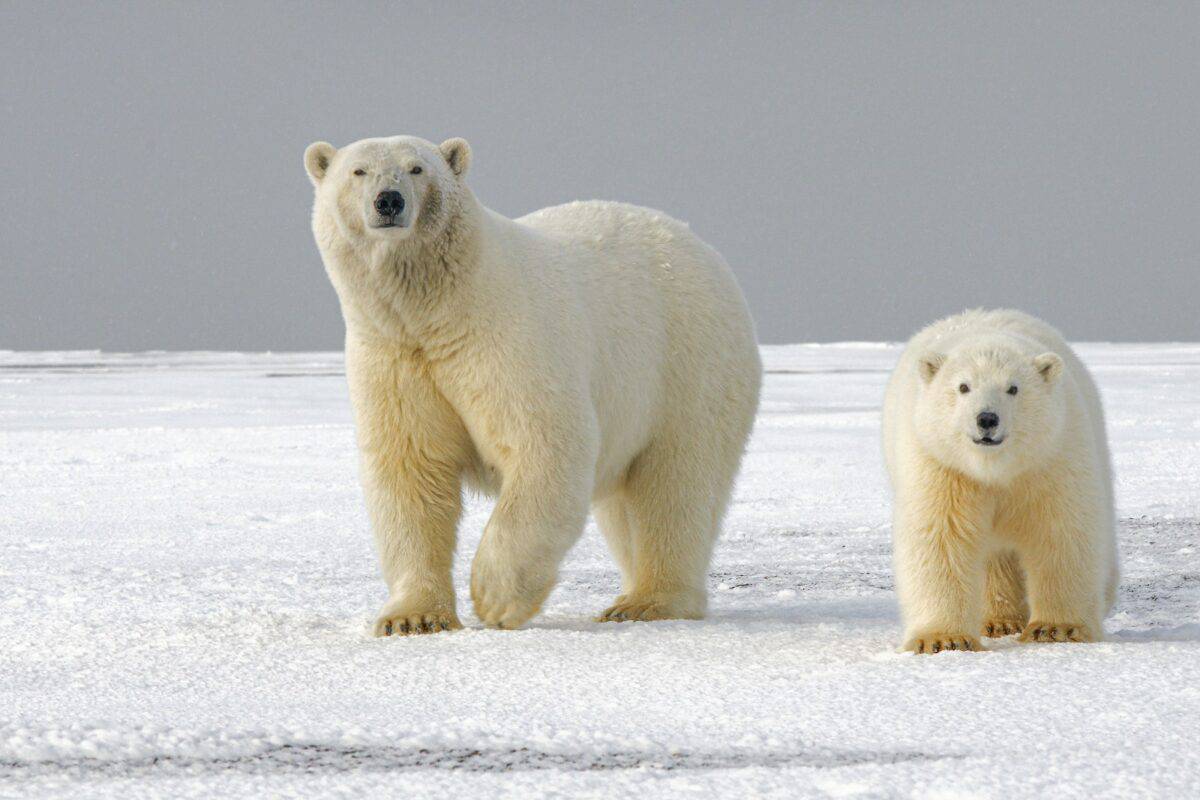North America is home to diverse ecosystems that support a remarkable array of predatory species. From the frozen tundra of the Arctic to the scorching deserts of the southwest, predators have adapted to thrive in virtually every habitat on the continent. While human fatalities from wildlife attacks remain relatively rare, understanding which species pose the greatest threat is essential for both safety and conservation. This article explores the 12 most dangerous predators in North America, examining their physical capabilities, behavior patterns, and the circumstances under which they might pose a threat to humans. These formidable hunters command our respect not just for their potential danger, but also for their crucial role in maintaining ecological balance across the continent.
12. Grizzly Bear
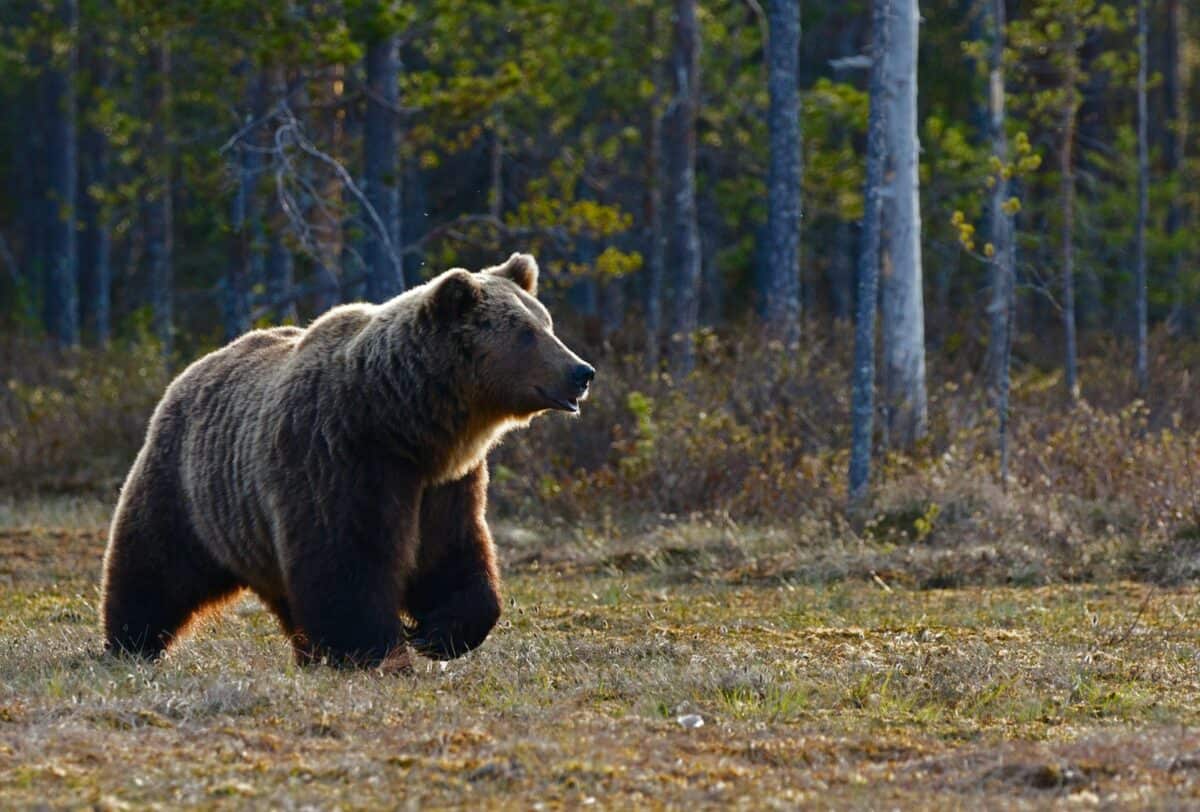
The North American grizzly bear (Ursus arctos horribilis) stands as one of the continent’s most formidable predators, with adult males weighing up to 800 pounds and standing over 7 feet tall when upright. These massive omnivores possess incredible strength, able to flip 700-pound rocks with ease while foraging. Their long, curved claws—measuring up to 4 inches—are powerful digging tools that also serve as deadly weapons. Grizzlies can reach speeds of 35 mph in short bursts, making outrunning them impossible for humans. While they don’t typically hunt people, most attacks occur when bears are surprised, defending cubs, or protecting a food source. The National Park Service records an average of one fatal grizzly attack per year in North America, primarily in Alaska, western Canada, Wyoming, and Montana. Despite their fearsome reputation, grizzly populations have declined significantly, making them protected under the Endangered Species Act in the contiguous United States.
11. Mountain Lion

The mountain lion (Puma concolor), also known as the cougar or puma, ranks among North America’s most efficient predators. These solitary big cats can weigh up to 200 pounds and measure over 8 feet from nose to tail tip. With powerful hind legs, mountain lions can leap 15 feet vertically and 40 feet horizontally, enabling them to ambush prey from elevated positions. Their hunting style typically involves stalking and a swift, powerful pounce, often breaking the neck of their prey with a precisely targeted bite. Mountain lions have the largest range of any wild mammal in the Americas, found from the Canadian Yukon to the southern Andes. While attacks on humans remain rare—with fewer than 30 fatalities recorded in North America since 1890—they appear to be increasing as human development encroaches on their habitat. Most attacks occur when the animals are starving, rabid, or when encountering humans who are alone, running, or with small children. Despite their danger potential, mountain lions play a vital role in controlling deer populations and maintaining ecosystem health.
10. American Alligator

The American alligator (Alligator mississippiensis) represents one of North America’s most ancient predators, having evolved over 8 million years ago. These reptilian hunters can grow up to 15 feet long and weigh over 1,000 pounds, though average males typically reach 11-12 feet. Equipped with 80 teeth designed for gripping rather than chewing, alligators possess a bite force measured at over 2,000 pounds per square inch—strong enough to crush a turtle’s shell. Their powerful tails enable bursts of speed up to 35 mph in water and 11 mph on land for short distances. Primarily found in the southeastern United States from Texas to North Carolina, alligators are responsible for an average of one fatality per year. Most attacks occur in Florida, where the human population increasingly overlaps with alligator habitat. These ambush predators are particularly dangerous in twilight hours when hunting, and during mating season (April-June) when males become more aggressive. Despite their fearsome capabilities, alligators play a crucial ecological role and were brought back from the brink of extinction through successful conservation efforts.
9. Gray Wolf

The gray wolf (Canis lupus) represents the largest wild member of the canid family in North America, with adults weighing between 80-120 pounds and measuring up to 6.5 feet from nose to tail tip. These apex predators hunt in coordinated packs, displaying remarkable intelligence and social cooperation that allows them to take down prey much larger than themselves, including moose and bison. Wolves possess extraordinary stamina, capable of traveling up to 100 miles in a single day while pursuing prey across their territory. Their jaws can exert 1,500 pounds of pressure per square inch—about twice the bite force of a German Shepherd. Despite their fearsome capabilities, confirmed wolf attacks on humans remain extremely rare in North America, with only two known fatal attacks in the 21st century. The danger they pose is primarily to livestock, creating conflict with ranchers. Since their reintroduction to Yellowstone National Park in 1995, studies have demonstrated wolves’ critical role in ecosystem health, triggering beneficial trophic cascades that increase biodiversity. Today, approximately 18,000 wolves inhabit North America, primarily in Canada and Alaska, with smaller recovering populations in the northern United States.
8. Polar Bear

The polar bear (Ursus maritimus) stands as the world’s largest land carnivore and North America’s most formidable Arctic predator. Adult males typically weigh 900-1,600 pounds and can reach nearly 10 feet in length. Unlike other bear species, polar bears are hypercarnivorous, meaning their diet consists of more than 70% meat, primarily ringed and bearded seals. Their massive paws, measuring up to 12 inches wide, serve as effective paddles for swimming up to 6 mph and can deliver devastating blows capable of killing a seal with a single strike. With 42 razor-sharp teeth and powerful jaws, they can easily crush the skull of their prey. Polar bears are one of the few animals known to actively hunt humans, particularly when hungry. Between 1870 and 2014, there were 73 documented polar bear attacks on humans, resulting in 20 fatalities. Climate change represents the greatest threat to polar bear populations, as diminishing sea ice reduces their hunting grounds and access to prey. Scientists estimate that the global population of 22,000-31,000 polar bears could decline by 30% by 2050 due to habitat loss, making encounters with desperate bears potentially more dangerous as they seek alternative food sources.
7. American Black Bear
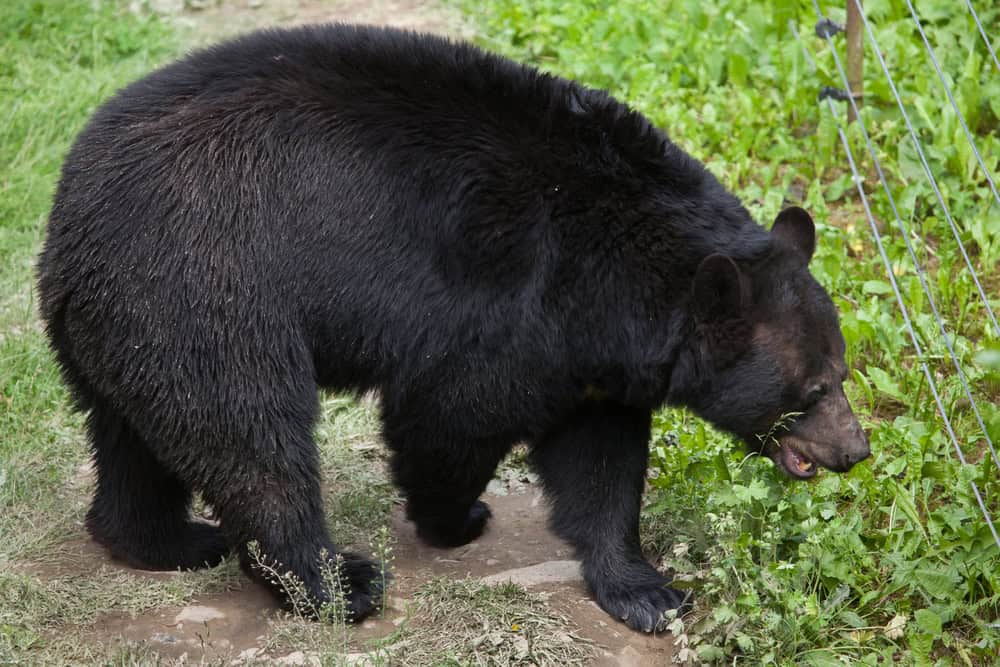
The American black bear (Ursus americanus) is North America’s most common bear species, with a population exceeding 800,000 spread across 40 states and most of Canada. Despite their name, these adaptable omnivores can be brown, cinnamon, or even white (in the rare Kermode or “spirit bear” variant). Smaller than their grizzly cousins, black bears still command respect with males weighing 250-500 pounds and measuring up to 6 feet in length. They possess remarkable dexterity, able to open screw-top jars and manipulate door latches, and can run at speeds up to 35 mph. Their climbing ability exceeds that of other North American bears, with even adult bears able to rapidly scale trees to escape threats. While generally less aggressive than grizzlies, black bears account for more human attacks in North America—63 fatal attacks were recorded between 1900 and 2009, with the majority being predatory in nature rather than defensive. This higher incident rate stems primarily from their larger population and greater overlap with human habitats. Black bears demonstrate exceptional adaptability, inhabiting environments from dense forests to suburban areas, which increases the potential for human-bear conflicts, particularly when bears become habituated to human food sources.
6. Timber Rattlesnake
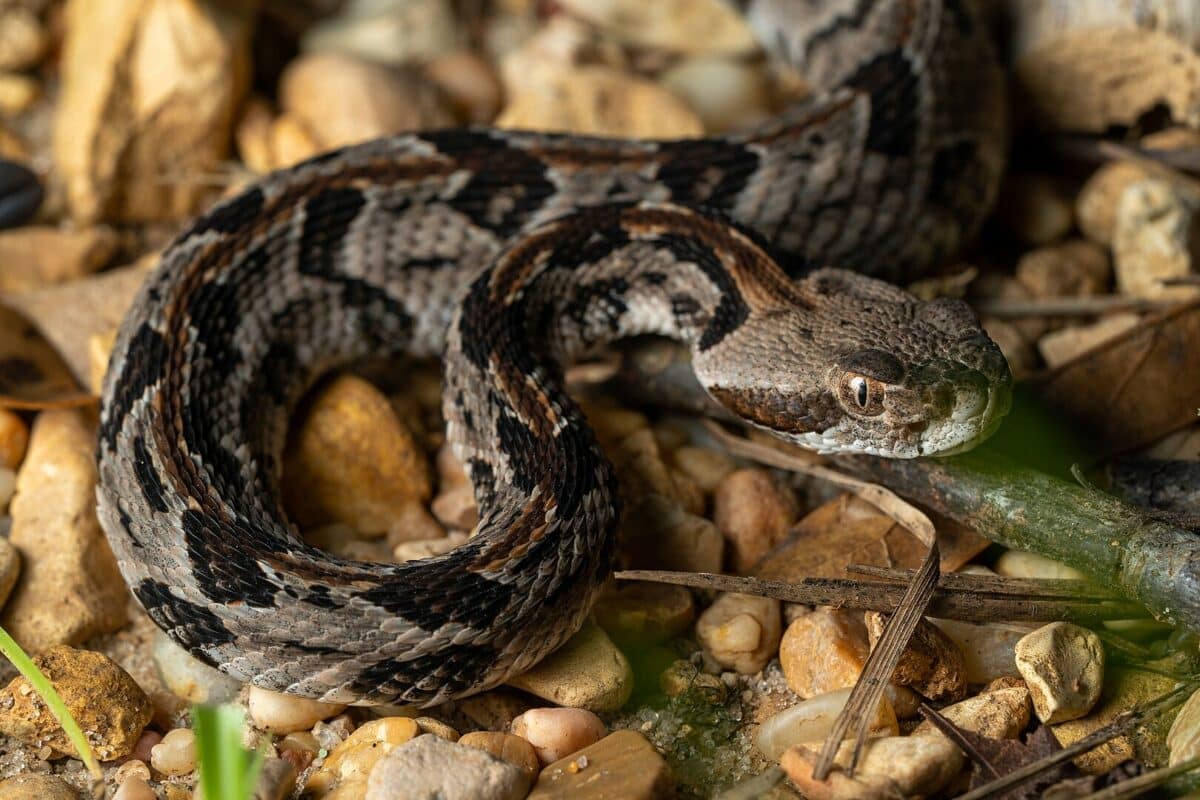
The timber rattlesnake (Crotalus horridus) ranks among North America’s most dangerous venomous serpents, with a potent hemotoxic venom that destroys tissue, causes internal bleeding, and prevents blood clotting. These pit vipers can grow up to 5 feet long and weigh 1.1-3.3 pounds, with distinctive “woodland” or “mountain” color phases ranging from yellow to black with dark chevron-shaped bands. Their iconic rattle consists of loosely interlocked segments of keratin that vibrate against each other when shaken, creating the distinctive warning sound that precedes a defensive strike. Timber rattlesnakes can accurately strike at one-third to one-half their body length, delivering venom through hollow, replaceable fangs that function like hypodermic needles. While not aggressive by nature, they account for a significant portion of the approximately 7,000-8,000 venomous snakebites reported annually in the United States, with a mortality rate of 10-30% if left untreated. Their historical range covered most of the eastern United States, but habitat destruction and persecution have led to their decline, with the species now protected in many states. Despite their dangerous potential, timber rattlesnakes play a crucial ecological role by controlling rodent populations, with a single snake capable of removing 2,500-4,500 ticks from the environment per year by consuming their rodent hosts.
5. Wolverine
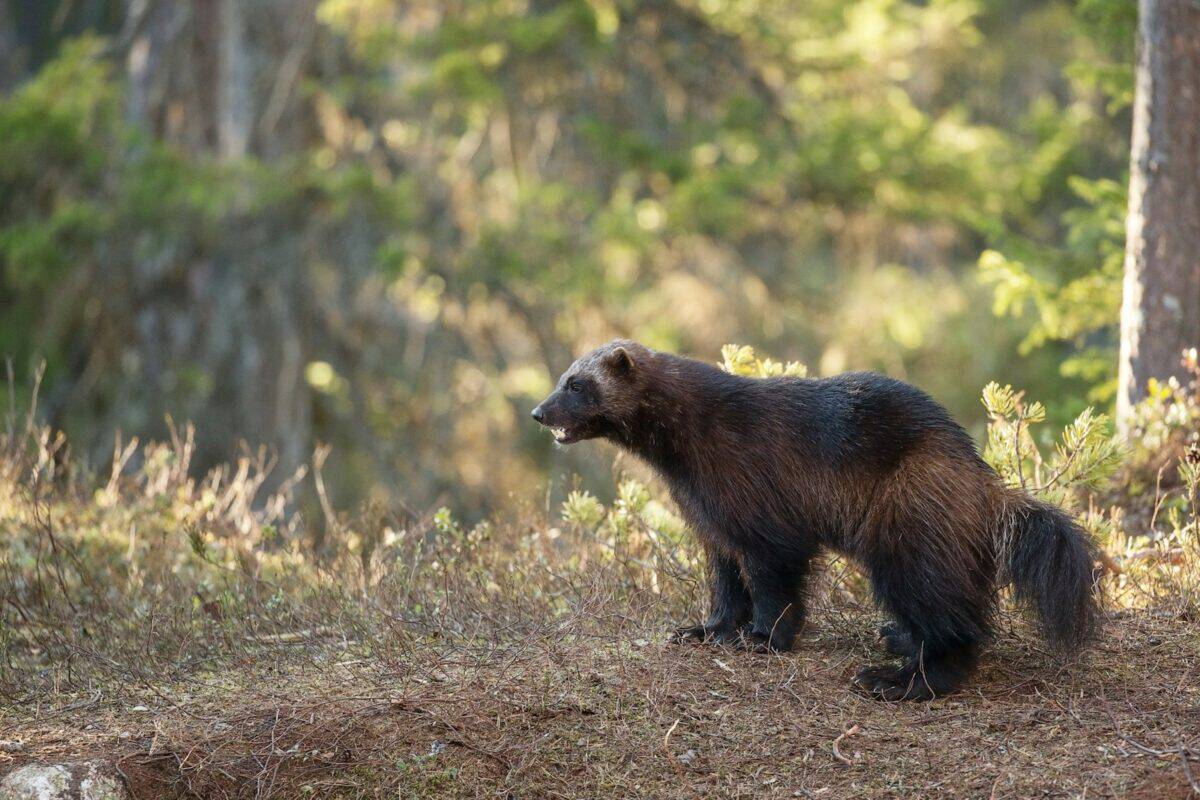
The wolverine (Gulo gulo), despite its relatively small size of 24-40 pounds and 2-3 feet in length, has earned the nickname “Devil Bear” for its ferocity and disproportionate strength. These stocky members of the weasel family possess powerful jaws and specialized molars that can crush frozen meat and bones, allowing them to scavenge carcasses other predators cannot utilize. Wolverines have been documented taking down prey ten times their size, including caribou and moose, especially when these larger animals are vulnerable in deep snow. Their semi-retractable claws, measuring up to two inches long, serve as effective weapons and climbing tools. Wolverines’ incredible stamina enables them to travel up to 15 miles daily across territories that can span 200-500 square miles, often traversing mountainous terrain. Their dense fur resists frost through unique adaptations, allowing them to thrive in some of North America’s harshest environments. While attacks on humans are extremely rare due to their remote habitats and relatively small population of 300-1,000 individuals in the contiguous United States, wolverines display remarkable aggression when cornered, capable of driving much larger predators, including bears and wolves, away from kills. Climate change threatens wolverine survival as they depend on persistent spring snow cover for successful reproduction.
4. Bull Shark

The bull shark (Carcharhinus leucas) stands out among North America’s most dangerous aquatic predators due to its unique ability to tolerate freshwater environments. These sharks can travel hundreds of miles up rivers and have been found in the Mississippi River as far north as Illinois, as well as in Lake Nicaragua and Lake Pontchartrain. Growing to lengths of 7-11.5 feet and weighing 200-500 pounds, bull sharks possess the strongest bite force of any shark species—approximately 1,350 pounds per square inch. Their stocky build and aggressive disposition make them particularly dangerous to humans, with the International Shark Attack File attributing more unprovoked attacks to bull sharks than any other species along North American coastlines. Their ability to hunt in shallow, often murky water where visibility is poor increases the likelihood of mistaken identity attacks. Bull sharks possess specialized kidneys and rectal glands that allow them to regulate salt and urea concentrations in their bloodstream, enabling their remarkable freshwater adaptability. This physiological feature, combined with their territorial aggression and indiscriminate feeding habits, contributes significantly to their danger status. Despite their fearsome reputation, bull shark populations face pressure from commercial fishing, habitat degradation, and climate change impacts on coastal nursery areas.
3. Western Diamondback Rattlesnake

The Western diamondback rattlesnake (Crotalus atrox) accounts for more snakebite fatalities in the United States than any other species, responsible for approximately 10-20% of all venomous snakebites in the country annually. These formidable pit vipers typically grow to 4-6 feet in length, with exceptional specimens reaching over 7 feet, and can weigh up to 10 pounds. Their venom contains a complex mixture of hemotoxins that destroy tissue, prevent blood clotting, and cause systemic hemorrhaging, with a single bite delivering 150-450mg of venom—enough to kill several adults if left untreated. Western diamondbacks can strike with lightning speed at distances up to two-thirds of their body length and can deliver multiple bites in rapid succession. Unlike some rattlesnake species, Western diamondbacks often stand their ground when threatened, making them particularly dangerous encounters. They inhabit diverse environments across the southwestern United States and northern Mexico, from deserts to grasslands and rocky hillsides, often adapting to suburban environments where development encroaches on their territory. Their distinctive diamond pattern, black-and-white banded tail, and loud, sustained rattling serve as warning signals. Despite their dangerous reputation, these snakes play a vital role in controlling rodent populations, with research suggesting a single rattlesnake can consume 10-30 rodents annually.
2. Great White Shark

The great white shark (Carcharodon carcharias) represents the largest predatory fish on Earth and one of North America’s most formidable oceanic hunters. These massive cartilaginous fish typically grow to 15-16 feet in length and weigh 1,500-4,000 pounds, though exceptional females can reach over 20 feet and weigh more than 7,000 pounds. Great whites possess up to 300 serrated, triangular teeth arranged in multiple rows that continuously regenerate throughout their lifetime, with some individuals producing over 20,000 teeth during their 70+ year lifespan. Their sensory capabilities are extraordinary, including electroreceptors called ampullae of Lorenzini that can detect half a billionth of a volt of electricity—enough to sense a fish’s heartbeat from miles away. Great whites inhabit coastal waters throughout North America, particularly concentrated around seal colonies from California to New England. Despite their fearsome reputation, enhanced by media portrayal, unprovoked attacks remain rare, with an average of 5-10 incidents annually along North American coasts. Of these attacks, approximately 10% prove fatal, usually due to blood loss rather than consumption. Research has revealed complex social hierarchies and hunting strategies among great whites, challenging the “mindless killer” stereotype. The species now receives protection in many jurisdictions as their populations face threats from commercial fishing, habitat degradation, and climate change.
1. Eastern Massasauga Rattlesnake
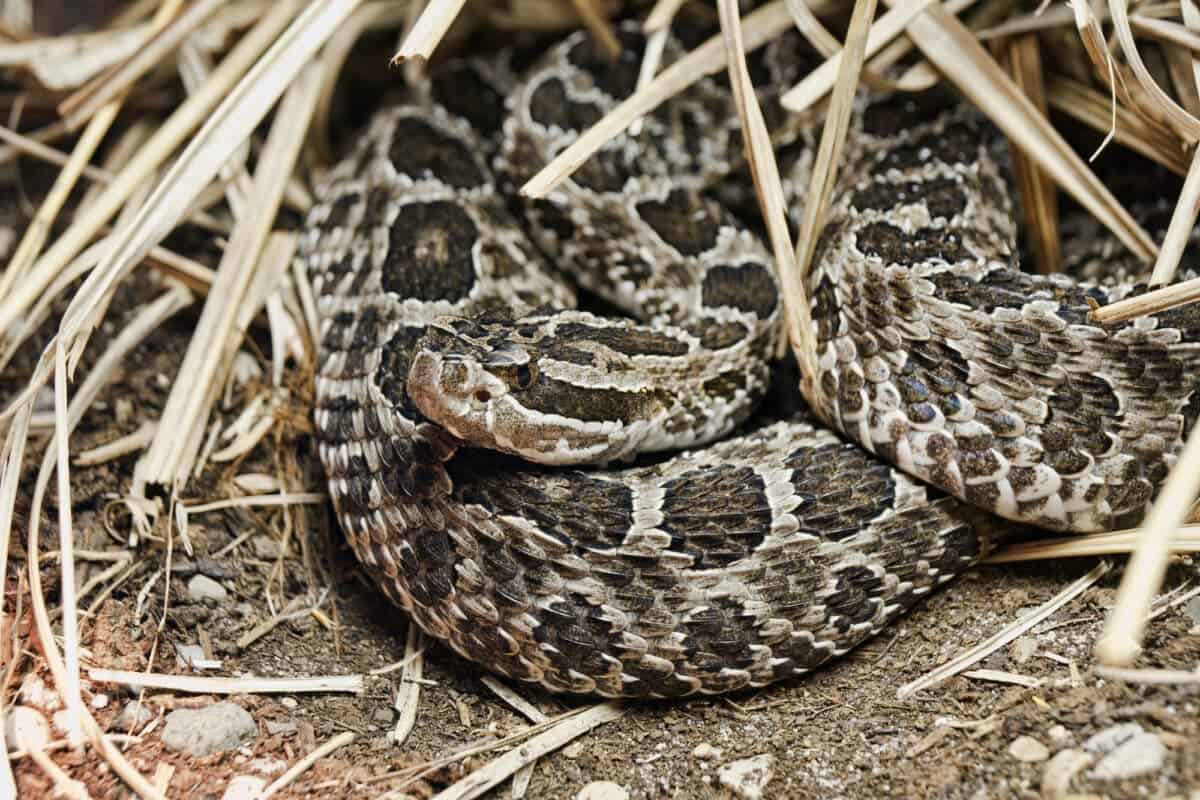
The Eastern massasauga rattlesnake (Sistrurus catenatus), though smaller than its western cousins at typically 2-3 feet in length, earns its place among North America’s dangerous predators due to its potent cytotoxic venom and endangered status. Often called the “swamp rattler,” this pit viper inhabits wet prairies, marshes, and bogs across the Great Lakes region and parts of the Midwest. Its distinctive features include a gray or brownish body with dark brown, rounded blotches and vertical pupils in copper-colored eyes. Unlike larger rattlesnakes, the massasauga produces a relatively quiet, subtle rattle that sounds more like buzzing insects, making it easier to overlook. Their venom, while delivered in smaller quantities than larger rattlesnake species, contains powerful myotoxins and hemorrhagic factors that destroy muscle tissue and prevent blood clotting. When untreated, bites can lead to tissue necrosis, internal bleeding, and in rare cases, death. Between 2000 and 2013, there were 59 recorded bites in the United States, but fatalities remain extremely rare due to effective antivenin treatment. The Eastern massasauga’s threatened status—with fewer than 10,000 remaining in fragmented populations—makes encounters increasingly uncommon. Conservation efforts focus on habitat preservation and public education to protect both humans and this misunderstood predator, which provides valuable ecological services through rodent control.
Conclusion

The dangerous predators of North America represent the pinnacle of evolutionary adaptation, having honed their hunting abilities over millions of years to become the perfect expressions of their ecological niches. While these 12 species command respect for their potential danger to humans, it’s important to recognize that attacks remain statistically rare, often occurring only when animals feel threatened or when humans fail to take proper precautions in wild habitats. Conservation efforts for many of these species remain critical, as their populations face unprecedented challenges
- 10 Animals That Mate for Life - August 18, 2025
- 12 Ocean Creatures Bigger Than Boats - August 18, 2025
- 10 States in the US With the Most Unique and Unusual Wildlife - August 18, 2025

